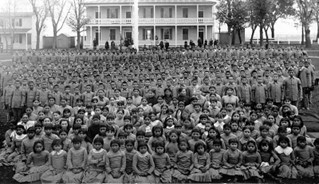Home > ASME Articles > Trauma, Stereotypes, & Discrimination Increase Risk for SUD/AUD in American Indian/Alaska Native Communities

This is a photo of students at the Carlisle Indian Industrial School in Pennsylvania, c. 1900
For a long time, it’s been a popular but false belief that American Indian/Alaska Natives (AI/AN) have a biological vulnerability (BV) to substance use disorders (SUDs), especially alcohol use disorder (AUD). The “firewater myth,” or belief of BV to AUD, has been shown to lead to heavier drinking and more alcohol-related consequences for Indigenous communities. Additionally, even those who have other racial identities with a strong family history may also have a BV to unhealthy alcohol use. Given all this, there must be something else that accounts for the high rates of SUD in AI/AN communities.
This review of the literature aimed to take a closer look at other factors that might be responsible, including psychosocial issues related to colonization and resultant disruption of language, ways of life, land and homes, rates of PTSD, poverty, stereotypes, and discrimination. By taking a closer look at the literature on what possible psychosocial findings in relation to the development or perpetuation of SUDs exist in AI/AN communities, we may be better able to support those communities in the future.
This scoping review, supported by by both the Robert Wood John Foundation and SAMHSA, was conducted in four databases: PsycINFO, PubMed, Embase, and Web of Science. The search yielded a total of 2,597 unique articles. After abstract and full-text screening for inclusion and exclusion criteria, 15 studies remained in the review.
In the reviewed studies, some notable themes stood out:
Trauma was linked in several studies to the increased risk of SUDs in the AI/AN population. Historical loss and individual childhood trauma were seen as boarding school attendance, out-of-home placement, and interpersonal physical, emotional, and sexual abuse were all associated with an increased risk of either AUD or high-risk drinking in general.
Trauma was also found to have a dose-related response to AUD – the more traumatic events someone experienced, the more likely they were to drink alcohol.
Stereotypes and the effects of discrimination also played a role in the development of AUD, with experiencing stereotypes and beliefs of having a BV to alcohol leading to depressive thoughts and feelings, and depression and low self-worth in turn leading to AUD and SUD.
This scoping review supports the theory that complex trauma leads to complex substance use disorders for AI/AN communities. Treatment for these communities needs to address more than just the substance use itself. The need for culturally appropriate treatment tailored for AI/AN communities is high, as is the need to expand partnerships with Tribes to better understand what constitutes a desired treatment outcome for each community as well, given differences in Tribal perceptions of health and well-being.
It’s also important to note that contemporary society continues to play a role in further perpetuating the stereotypes and discrimination that feed into high rates of AUD and SUD in AI/AN communities in the first place. These stereotypes fuel the false belief held by clinicians (and others) that AI/AN patients are more prone to certain behaviors or traits, like BV to AUD, which can make AI/AN individuals feel as if they have no control over their use, which has been found to lead to increased drinking days. These beliefs are extremely harmful.
Discrimination also takes a high toll on AI/AN people, reinforcing the historical trauma and ongoing pain these communities experience. AI/AN people can be subject to widespread misrepresentations and microaggressions, everything from sports team mascots to “Indian princess” outfits worn by young white women at events like Coachella. Though some of us may not have enough power to change systems in our workplaces overnight, we all have the power to make a difference on an individual, family, neighborhood, and even community level, by looking inward at our own biases, speaking up when we encounter bias in others, and doing what we can to act as better allies to our AI/AN friends, colleagues, and neighbors.
Need help getting a copy? Email Meg Brunner.